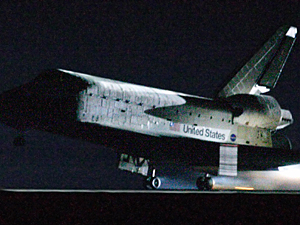|
Photos
|
August 9, 2005
 |
| Space Shuttle Discovery lands at NASA's Dryden Flight Research Center on Edwards Air Force Base. (ROBYN BECK/AFP/Getty Images) |
Edwards Air Force Base, Calif. — (AP) - Discovery and its crew of seven glided safely back to Earth on Tuesday, ending a riveting, at times agonizing, 14-day test of space shuttle safety that was shadowed by the ghosts of Columbia.
Discovery swooped through the darkness of the Mojave Desert and landed on the Edwards runway at 5:11 a.m. PDT, well before sunrise. It marked the conclusion of the first shuttle re-entry since Columbia's tragic return.
The detour to California came after thunderstorms in Cape Canaveral, Fla., prevented the shuttle from returning to its home base.
"Congratulations on a truly spectacular test flight," Mission Control said once Discovery came to a stop. "Welcome home, friends."
"We're happy to be back and we congratulate the whole team for a job well done," Commander Eileen Collins replied.
The inherently dangerous ride down through the atmosphere - more anxiety-ridden than normal because of what happened to Columbia 2½ years ago - appeared to go smoothly. No problems were immediately reported by Mission Control.
Held up a day by bad weather in Florida, the shuttle soared across the Pacific and over Southern California, passing just north of Los Angeles on its way to Edwards. NASA adjusted the flight path in order to skirt Los Angeles because of new public safety considerations in the wake of the Columbia disaster, which rained debris onto Texas and Louisiana.
Discovery's journey, which began with a liftoff on July 26, spanned 219 orbits of Earth and 5.8 million miles.
The switch to the opposite coast was a big disappointment for the astronauts' families, who had been waiting to greet their loved ones in Cape Canaveral. Their reunion was put on hold until Wednesday, when they all planned to meet in Houston.
NASA's top officials also had gathered at Cape Canaveral to welcome the crew home.
"There's nothing more that I would love to see than it here so everybody here could be a part of this. But it's not going to be," said shuttle program manager Bill Parsons. "I want it to be safe, wherever the safest place is to go."
NASA called it a test flight and it was - in an alarming way no one anticipated. A potentially deadly 1-pound chunk of foam insulation came off the redesigned fuel tank during liftoff, missing Discovery but demonstrating that the space agency had not resolved the very problem that doomed Columbia.
The foam loss prompted NASA to ground future shuttle flights.
Shuttle managers freely acknowledged the mistake, while stressing that the inspection, photography and other shuttle data-gathering systems put in place for this flight worked exceedingly well. What's more, no severe damage was detected on Discovery while it was in orbit.
A torn thermal blanket under a cockpit window was left as is, after engineers decided it posed little risk as re-entry shrapnel.
Two pieces of filler material dangling from Discovery's belly, however, were removed by a spacewalking astronaut last week, for fear they could lead to a repeat of the Columbia tragedy. The fabric strips slipped out of the narrow gaps between thermal tiles for reasons unknown.
NASA officials said a space shuttle will not fly again until the foam problem is solved and engineers understand why the two so-called gap fillers came loose.
Until the spacewalk to pull out the two protruding gap fillers, astronauts had never ventured beneath an orbiting shuttle or made repairs to its fragile thermal shielding.
"It's going to be a new beginning for the space shuttle program," NASA's spaceflight chief, Bill Readdy, said from the Cape Canaveral landing strip. "The approach that we've taken has to do with a very methodical series of flight tests. It's exactly the right approach.
"This was certainly the most documented flight in shuttle history," Readdy added.
The shuttle astronauts spent nine days at the international space station, restoring full steering capability to the orbiting outpost, delivering much-needed supplies and replacement parts, and hauling away a 2½-year backlog of trash.
They successfully conducted three spacewalks, including one to test new tools and methods for fixing a damaged shuttle heat shield in orbit. They also pulled off some fancy new flying maneuvers, flipping Discovery end over end near the space station so its two residents could zoom in with cameras as part of the exhaustive search for shuttle damage.
Flight director LeRoy Cain said over the weekend that not only did NASA learn a lot about the shuttle with this mission, but "we've learned a lot about ourselves."
Following the Feb. 1, 2003, Columbia catastrophe, NASA revamped the way it managed a shuttle mission. The mission management team met daily while Discovery was in orbit, taking time to listen to dissenting opinions and encouraging them as well, according to its chairman, deputy shuttle program manager Wayne Hale. Every potential serious problem was analyzed by a team of engineers and, in the case of the ripped blanket, even prompted a series of wind tunnel tests.
Some accused the space agency of going too far to reach a group consensus and having "analysis paralysis." Shuttle officials denied that was so and said their intent was to put the astronauts' safety first no matter what, an assessment shared by Discovery's co-pilot, James Kelly.
"Just the fact that we're here means we don't have paralysis by analysis," Kelly said from orbit Sunday. "The folks on the ground have done an absolutely great job trying to take care of everything they possibly can."




